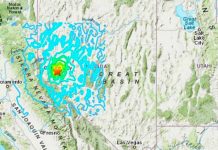
April 4 (UPI) — California voters approved Proposition 64 in November 2016, allowing the retail sale of marijuana to adults for recreational purposes from Jan. 1, 2018. Since then, several cities in the Coachella Valley have moved to embrace industrial-scale marijuana growing.
Leading the pack is Desert Hot Springs, a city of 28,000 people that has struggled in the shadow of Palm Springs for decades. As the city tilted toward municipal bankruptcy in 2014, it decided to embrace marijuana as a revenue source. Voters approved local ballot measures allowing the city to tax marijuana dispensaries and growing operations, and the city reclaimed a vast tract of mostly vacant industrial land to allow indoor marijuana cultivation.
“The [marijuana] industry started coming out and buying up all the land,” said Mayor Scott Matas. “The only thing left there are a couple churches and a pool supply store. Everything else was bought by the industry. All the dilapidated auto parts places are gone and everything’s being reconstructed, which is nice.”
Initially the city intended to embrace only medical marijuana, but the first growers who sought permits asked the city to add language allowing marijuana cultivation for recreational purposes, if that was ever legalized, long before Prop. 64 hit the statewide ballot. They got the language, and the proposition later passed.
As a result, Desert Hot Springs has been besieged with applicants for cultivation permits, industrial land has been snapped up at record prices, and massive warehouse-style buildings are being erected to create climate-controlled indoor marijuana farms.
Seven marijuana dispensaries are already open in Desert Hot Springs, and two more are going through the permit process. The city has 43 permit applications from growers that it has either already approved or is reviewing. Two growers are up and running, with three more under construction.
But little has been said about water demand. Despite a long history of groundwater overdraft in the region, Matas said he’s not concerned.
“An 18-hole golf course uses four to five times the amount of water one of these large cultivators would use,” he said. “We don’t think it’s going to impact our aquifers.”
Local environmental groups are withholding judgment as they watch the industry unfold.
“It’s in kind of a state of flux right now, so we’ll just have to wait and see,” said Jeff Morgan, chairman of the Sierra Club’s Tahquitz Group. “I think there is limited demand, and I think it will be easily exceeded once you get a few large players in the game.”
But no one knows how big the industry could get. Wall Street investors are already getting into the marijuana business, and one analyst projects U.S. sales of legal marijuana could grow nine-fold in the next decade alone.
Desert Hot Springs could be well positioned as a center of cultivation: It’s only a two-hour drive from Los Angeles, the nation’s second-largest metropolitan area.
The new growers in Desert Hot Springs will buy water from Mission Springs Water District, the local water and sewage treatment utility. The district relies exclusively on groundwater to meet all water demand in the area and has no other customers that could be defined as “agriculture.”
According to its 2016 Urban Water Management Plan, the district’s primary aquifer has shrunk about 100 feet since the 1950s as a result of urbanization and scarce precipitation in the region. Overdraft is now estimated at 9,000 acre-feet per year, enough to serve 20,000 average homes annually.
Together with other water agencies in the Coachella Valley, in 2001, Mission Springs Water District began a program to replenish the aquifer with water imported from the Colorado River. This has begun to reverse the overdraft problem. The replenishment water is expected to be necessary for the foreseeable future to sustain the aquifer.
Now with a thirsty new agricultural industry in town, the effects on the aquifer remain unclear, because it will be several years until the industry is fully developed.
“Right now, we don’t see a demand that exceeds our supply, or even, thus far, that threatens the sustainability of our supply,” said John Soulliere, spokesman for the Mission Springs Water District.
Other cities in the region have also opened their gates to marijuana cultivators, including nearby Cathedral City and Coachella. But none has been as inviting as Desert Hot Springs, said Greta Carter, partner of High Road Consulting Group, a firm working with a number of growers to set up cultivation facilities.
“I will tell you that, hands down, the city has been more embracing and receptive to our industry than others have,” Carter said. “Some cities will try to overregulate us. Desert Hot Springs has been rational about what the right amount of regulation is. We believe we have found a piece of heaven here, so we’re pretty excited.”
Mission Springs Water District is not imposing any unique water supply regulations on the marijuana industry, Soulliere said. Each new grower will get a water connection appropriate for their size and will pay a metered water bill, just like any other commercial customer.
The district is counting on growers to adopt tight water conservation measures to control costs, he said.
“We’re delighted, frankly, with the practices they’re employing,” Soulliere said. “At the end of the day, if their product is too expensive because they’re wasting water, then they’re not going to be in business very long.”
The growers Carter is working with all rely on frugal drip irrigation systems. They also plan to capture all drain water from plants and recycle it multiple times using reverse osmosis systems. The growing rooms will include systems to capture humidity emitted by the plants and channel that into the water supply system.
“We’re trying our absolute best to not let any water go down the drain that we can potentially capture and reuse,” Carter said.
Where growers could run into trouble is with the drain water they return to the sewage treatment system. The water district is requiring them to submit monthly testing reports, verified by an engineer, detailing any contaminants in the wastewater such as fertilizers and pesticides. They could be fined, for example, for excessive salinity, which would increase the water district’s treatment costs.
Carter said her growers are installing systems that will create drain water that is less saline than the source water.
“It’s far cheaper, from our point of view, to replace filters than to pay a fine from the district for giving them water that’s not acceptable,” said Carter, who is also executive director of the Desert Hot Springs Cannabis Alliance Network, a nonprofit trade organization.
There’s still a lot of debate and confusion about how much water marijuana plants actually consume.
A recent study led by scientists at the California Department of Fish and Wildlife estimated a single marijuana plant consumes as much as 6 gallons of water each day. That study focused on outdoor growing, and it soon came under attack by the industry, which argued a more accurate number is 2 gallons per day or less.
Indoor growing, as required in Desert Hot Springs, will likely use a lot less water because every step in the process is carefully controlled. Carter estimates each marijuana plant in her facilities will consume a half-gallon of water per day or less.
The 30,000-square-foot growing facility she has under construction will house about 10,000 marijuana plants under year-round growing conditions. At a half-gallon per plant, that equals the daily water consumption of about 16 average households, assuming household water use of 360 gallons per day.
Some of the new growing operations in Desert Hot Springs will be much larger, however. The city has approved one that will stretch over 1.8 million square feet. That’s as big as nine large Walmart stores. Another is proposed at 1 million square feet.
Growers have the option to drill their own water wells: There are no local regulations preventing that. But it would be an expensive option. Groundwater in many locations lies as much as 1,000 feet deep. That makes for a costly drilling operation. Pumping groundwater also requires a lot of expensive electricity.
Carter said she doesn’t know any grower who plans to drill their own well.
“For people to come in and be irresponsible won’t be tolerated,” Carter said. “No one should be fearful of us, because we’re under a microscope right now and we will continue to perform underneath that microscope.”
Matt Weiser is a contributing editor at Water Deeply. This article originally appeared on Water Deeply, and you can find the original here. For important news about the California drought, you can sign up to the Water Deeply email list. ![]()





